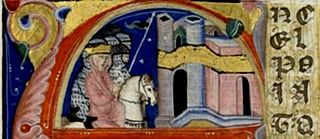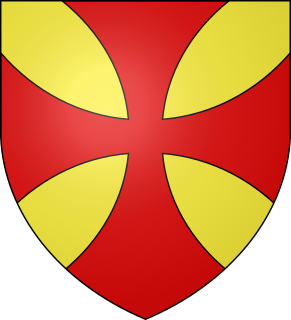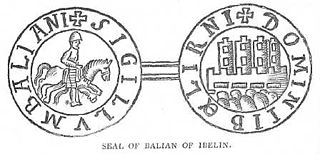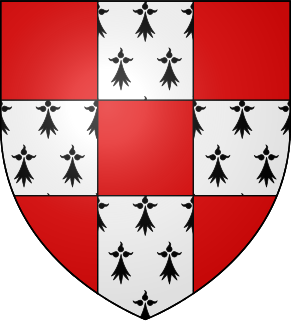Hugh III, also called Hugh of Antioch-Lusignan and the Great, was the king of Cyprus from 1267 and king of Jerusalem from 1268. Born into the family of the princes of Antioch, he effectively ruled as regent for underage kings Hugh II of Cyprus and Conrad III of Jerusalem for several years. Prevailing over the claims of his cousin Hugh of Brienne, he succeeded both young monarchs upon their deaths and appeared poised to be an effective political and military leader.

Alice of Champagne was the queen consort of Cyprus from 1210 to 1218, regent of Cyprus from 1218 to 1223, and of Jerusalem from 1243 to 1246. She was the eldest daughter of Queen Isabella I of Jerusalem and Count Henry II of Champagne. In 1210, Alice married her step-brother King Hugh I of Cyprus, receiving the County of Jaffa as dowry. After her husband's death in 1218, she assumed the regency for their infant son, King Henry I. In time, she began seeking contacts within her father's counties in France to bolster her claim to Champagne and Brie against her cousin, Theobald IV. However, the kings of France never acknowledged her claim.

Hugh I succeeded to the throne of Cyprus on 1 April 1205 underage upon the death of his elderly father Aimery, King of Cyprus and Jerusalem. His mother was Eschiva of Ibelin, heiress of that branch of Ibelins who had held Bethsan and Ramleh.

The Crusader state of the Kingdom of Jerusalem, created in 1099, was divided into a number of smaller seigneuries. According to the 13th-century jurist John of Ibelin, the four highest crown vassals in the kingdom proper were the count of Jaffa and Ascalon, the prince of Galilee, the lord of Sidon, and the lord of Oultrejordain.

There were six major officers of the kingdom of Jerusalem: the constable, the marshal, the seneschal, the chamberlain, the butler and the chancellor. At certain times there were also bailiffs, viscounts and castellans.

The King of Jerusalem was the supreme ruler of the Kingdom of Jerusalem, a Crusader state founded in Jerusalem by the Latin Catholic leaders of the First Crusade, when the city was conquered in 1099.

The House of Ibelin was a noble family in the Crusader Kingdom of Jerusalem in the 12th century. They rose from humble beginnings to become one of the most important families in the kingdom, holding various high offices and with extensive holdings in the Holy Land and Cyprus. The family disappeared after the fall of the Kingdom of Cyprus in the 15th century.
Baldwin of Ibelin, also known as Baldwin II of Ramla, was an important noble of the Kingdom of Jerusalem in the 12th century and was lord of Ramla from 1169-1186. He was the second son of Barisan of Ibelin, and was the younger brother of Hugh of Ibelin and older brother of Balian of Ibelin. He first appears in the historical record as a witness to charters in 1148.

Balian of Ibelin, also known as Barisan the Younger, was a crusader noble of the Kingdom of Jerusalem in the 12th century. He was lord of Ibelin from 1170 to 1193. As the leader of the defense of the city during the siege of Jerusalem in 1187, he surrendered Jerusalem to Saladin on October 2, 1187.
John of Ibelin, called the Old Lord of Beirut, was a powerful crusader noble in the 13th century, one of the best known representatives of the influential Ibelin family. The son of Balian of Ibelin and the dowager queen Maria Comnena, he had close ties with the nobility of both Cyprus and Jerusalem, since he was the half-brother of Queen Isabella I of Jerusalem. Before he was 20, he was appointed constable of Jerusalem, and a few years later became lord of Beirut. John rebuilt Beirut after Saladin's conquest, and established the grand Ibelin family palace. He served as regent of Jerusalem on behalf of his niece Maria of Montferrat from 1205 to 1210 after her mother, Queen Isabella, died. He was also regent for Isabella's grandson Henry I of Cyprus from 1228 until Henry came of age in 1232. John was known as a principled man, and was seen as the natural leader of the Christian barons in the Holy Land. He resisted the power-seeking of Frederick II, Holy Roman Emperor, in Cyprus, and opposed the imperial forces until King Henry came of age.
John of Ibelin, count of Jaffa and Ascalon, was a noted jurist and the author of the longest legal treatise from the Kingdom of Jerusalem. He was the son of Philip of Ibelin, bailli of the Kingdom of Cyprus, and Alice of Montbéliard, and was the nephew of John of Ibelin, the "Old Lord of Beirut". To distinguish him from his uncle and other members of the Ibelin family named John, he is sometimes called John of Jaffa.

The double County of Jaffa and Ascalon was one of the four major seigneuries comprising the major Crusader state of the Kingdom of Jerusalem, according to 13th-century commentator John of Ibelin.

The Principality of Galilee was one of the four major seigneuries of the crusader Kingdom of Jerusalem, according to 13th-century commentator John of Ibelin. The direct holdings of the principality centred around Tiberias, in Galilee proper, but with all its vassals, the lordship covered all Galilee and southern Phoenicia. The independent Lordship of Sidon was located between Galilee's holdings. The principality also had its own vassals: the Lordships of Beirut, Nazareth, and Haifa.

Maria Komnene, Latinized Comnena, was the queen of Jerusalem from 1167 until 1174 as the second wife of King Amalric. She occupied a central position in the Kingdom of Jerusalem for twenty years, earning a reputation for intrigue and ruthlessness.
John of Ibelin, often called John II, was the Lord of Beirut from 1254, named after his grandfather John I, the famous "Old Lord of Beirut". His parents were Balian of Ibelin and Eschiva, daughter of Walter of Montbéliard and Burgundia of Cyprus.
Guy of Ibelin, of the Ibelin family, was count of Jaffa and Ascalon during the latter part of the Crusades. He was the son of John of Ibelin and Maria of Barbaron. He was count in name only. His father, John of Jaffa, had died in 1266, after which the fragile truce with the Muslims collapsed, and Jaffa was captured by Baibars in 1268. John was probably succeeded by Guy's older brother James, who held the title of Count of Jaffa until his death in 1276, at which point the title passed to Guy.
Isabella of Ibelin (1241–1324) was queen of Cyprus and Jerusalem by marriage to Hugh III of Cyprus.

The War of the Lombards (1228–1243) was a civil war in the Kingdom of Jerusalem and the Kingdom of Cyprus between the "Lombards", the representatives of the Emperor Frederick II, largely from Lombardy, and the Eastern aristocracy led first by the Ibelins and then by the Montforts. The war was provoked by Frederick's attempt to control the regency for his young son, Conrad II of Jerusalem. Frederick and Conrad represented the Hohenstaufen dynasty.

Melisende was the hereditary Lady of Arsuf from 1177 and the second wife of the powerful nobleman John, Old Lord of Beirut.

Alice de la Roche, Lady of Beirut, Regent of Beirut was the wife of John II, Lord of Beirut in the Kingdom of Jerusalem. She was a daughter of Guy I, Lord of Athens. Alice is sometimes referred to as Alice of Athens. Alice was regent of Beirut for her daughter, Lady Isabella, while Isabella was the queen consort of Cyprus.











